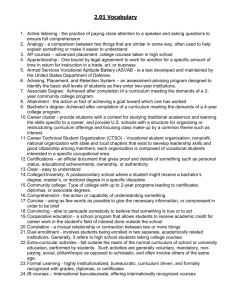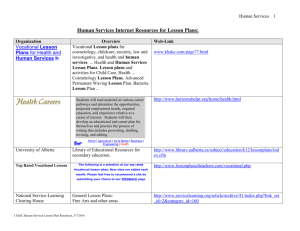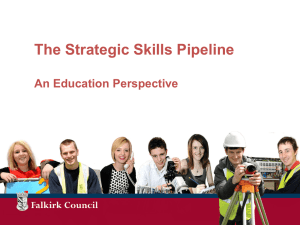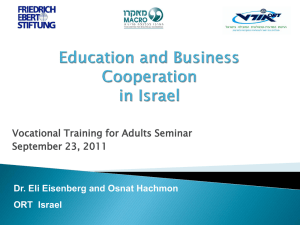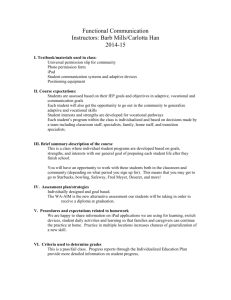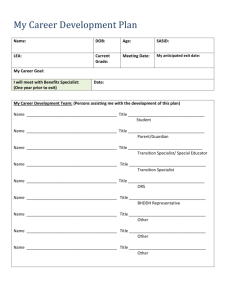Business – Human Resources Program Standard (MCU Code
advertisement
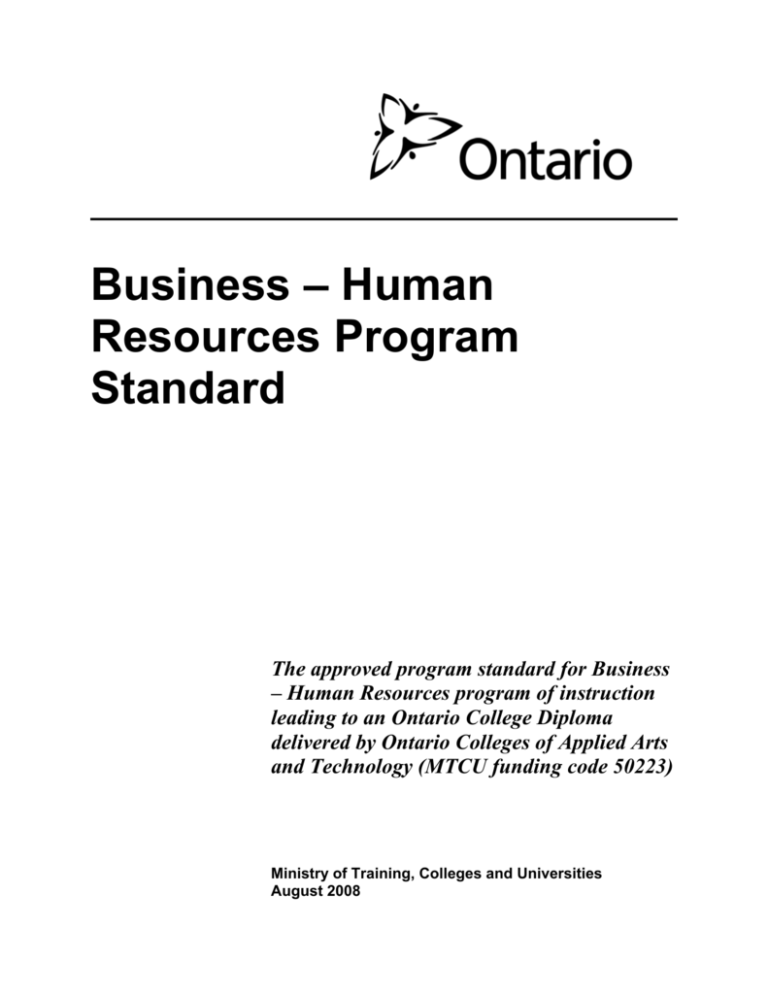
Business – Human Resources Program Standard The approved program standard for Business – Human Resources program of instruction leading to an Ontario College Diploma delivered by Ontario Colleges of Applied Arts and Technology (MTCU funding code 50223) Ministry of Training, Colleges and Universities August 2008 Permission to Reproduce Permission is hereby granted to the following institutions to reproduce this document, in whole or in part, in print or by electronic means, for the following specific purposes, subject to the conditions that follow: 1. 2. By an Ontario college of applied arts and technology for the purposes of implementation of the program standard within a college program, including for the purpose of informing students, potential students, program advisory committees or others about programs of study. By an educational institution or school, for the purpose of informing prospective college students about programs of study at Ontario colleges of applied arts and technology. Conditions: 1. 2. 3. 4. Every reproduction must be marked “© 2009, Queen’s Printer for Ontario” at the beginning of the document or any part of it that is reproduced. No other uses may be made of the document. The document may not be reproduced for sale. The Ministry may revoke the permission to reproduce at any time. For permission to copy this document, in whole or in part, for other purposes or by other institutions, please contact Ministry of Training, Colleges and Universities Programs Branch, Program Standards and Evaluation Unit 23rd floor, Mowat Block 900 Bay Street Toronto, Ontario M7A 1L2 Telephone: (416) 325-2874 E-mail: susan.golets@ontario.ca Inquiries regarding specific Business – Human Resources programs offered by colleges of applied arts and technology in Ontario should be directed to the relevant college. This publication is available on the Ministry’s Website at http://www.edu.gov.on.ca 8 2009, Queen’s Printer for Ontario ISBN 978-1-4249-7855-7 (PDF) Acknowledgements The Ministry of Training, Colleges and Universities acknowledges with thanks the significant contribution of the many individuals and organizations who participated in the development of this program standard. In particular, the Ministry of Training, Colleges and Universities would like to acknowledge the important roles of $ all individuals and organizations who participated in the consultations; $ the coordinators of Business – Human Resources Programs for their assistance throughout the project, the project officer who led the development of the vocational standard, Christine Foster, seconded faculty member from Algonquin College. Table of Contents I. Introduction........................................................................................................................1 Development of System-Wide Program Standards .............................................................1 Program Standards ...............................................................................................................1 The Expression of Program Standards as Vocational Learning Outcomes .........................2 The Presentation of the Vocational Learning Outcomes .....................................................2 The Development of a Program Standard............................................................................2 Updating the Program Standard...........................................................................................3 II. Vocational Standard ..........................................................................................................4 Preamble ..............................................................................................................................4 Synopsis of the Vocational Learning Outcomes..................................................................5 The Vocational Learning Outcomes ............................................................................ 6 - 17 Glossary .............................................................................................................................18 III. Essential Employability Skills.........................................................................................19 Context...............................................................................................................................19 Skill Categories..................................................................................................................19 Application and Implementation................................................................................ 20 - 21 IV. General Education Requirement....................................................................................22 Requirement.......................................................................................................................22 Purpose...............................................................................................................................22 Themes....................................................................................................................... 23 - 25 I. Introduction This document is the Program Standard for the Business – Human Resources program of instruction leading to an Ontario College Diploma delivered by Ontario colleges of applied arts and technology (MTCU funding code 50223). Development of System-Wide Program Standards In 1993, the Government of Ontario initiated program standards development with the objectives of bringing a greater degree of consistency to college programming offered across the province, broadening the focus of college programs to ensure graduates have the skills to be flexible and to continue to learn and adapt, and providing public accountability for the quality and relevance of college programs. The Program Standards and Evaluation Unit of the Ministry of Training, Colleges and Universities has responsibility for the development, review, and approval of system-wide standards for programs of instruction at Ontario colleges of applied arts and technology. Program Standards Program standards apply to all similar programs of instruction offered by colleges across the province. Each program standard for a postsecondary program includes the following elements: $ Vocational standard (the vocationally specific learning outcomes which apply to the program of instruction in question); $ Essential employability skills (the essential employability skills learning outcomes which apply to all programs of instruction); and $ General education requirement (the requirement for general education in postsecondary programs of instruction). Collectively, these elements outline the essential skills and knowledge that a student must reliably demonstrate in order to graduate from the program. Individual colleges of applied arts and technology offering the program of instruction determine the specific program structure, delivery methods, and other curriculum matters to be used in assisting students to achieve the outcomes articulated in the standard. Individual colleges also determine whether additional local learning outcomes will be required to reflect specific local needs and/or interests. The Expression of Program Standards as Vocational Learning Outcomes Vocational learning outcomes represent culminating demonstrations of learning and achievement. They are not simply a listing of discrete skills, nor broad statements of knowledge and comprehension. In addition, vocational learning outcomes are interrelated and cannot be viewed in isolation of one another. As such, they should be viewed as a comprehensive whole. They describe performances that demonstrate that significant integrated learning by graduates of the program has been achieved and verified. Expressing standards as vocational learning outcomes ensures consistency in the outcomes for program graduates, while leaving to the discretion of individual colleges curriculum matters such as the specific program structure and delivery methods. The Presentation of the Vocational Learning Outcomes The vocational learning outcome statements set out the culminating demonstration of learning and achievement that the student must reliably demonstrate before graduation. The elements of the performance for each outcome define and clarify the level and quality of performance necessary to meet the requirements of the vocational learning outcome. However, it is the performance of the vocational learning outcome itself on which students are evaluated. The elements of performance are indicators of the means by which the student may proceed to satisfactory performance of the vocational learning outcome. The elements of performance do not stand alone but rather in reference to the vocational learning outcome of which they form a part. The Development of a Program Standard In establishing the standards development initiative, the Government determined that all postsecondary programs of instruction should include vocational skills coupled with a broader set of essential skills. This combination is considered critical to ensuring that college graduates have the skills required to be successful both upon graduation from the college program and throughout their working and personal lives. A program standard is developed through a broad consultation process involving a range of stakeholders with a direct interest in the program area, including employers, professional associations, universities, secondary schools, and program graduates working in the field, in addition to students, faculty, and administrators at the colleges themselves. It represents a consensus of participating stakeholders on the essential learning that all program graduates should have achieved. 2 I Introduction Updating the Program Standard The Ministry of Training, Colleges and Universities will undertake regular reviews of the vocational learning outcomes for this program to ensure that the Business – Human Resources Program Standard remains appropriate and relevant to the needs of students and employers across the Province of Ontario. To confirm that this document is the most up-to-date release, contact the Ministry of Training, Colleges and Universities at the address or telephone number noted on the inside cover page. I Introduction 3 II. Vocational Standard All graduates of the Business – Human Resources program of instruction must have achieved the 12 vocational learning outcomes listed in the following pages, in addition to achieving the essential employability skills learning outcomes and meeting the general education requirement. Preamble Graduates of Business – Human Resources Programs carry out human resources functions within the Canadian business environment. Graduates have therefore demonstrated achievement of vocational learning outcomes which relate to both business in general and human resources in particular. Graduates of the Business – Human Resources Programs are prepared to participate in staffing, performance management*, training, employee relations, health and safety, and benefits and compensation administration functions. They are also able to apply communication, information technology, teamwork, and organizational development* strategies to support the human resources activities of an organization. Graduates of Business – Human Resources Programs are employed in a broad range of private, public, and not-for-profit sectors of business and industry including manufacturers, retailers, banks and other financial institutions, medical facilities, government offices, human resources consulting firms, and other large and small businesses. There are opportunities for graduates to pursue further educational qualifications; through articulation agreements between the colleges and universities, graduates may be granted credits towards a degree. Students should contact individual colleges for further details of a college’s articulation agreements with universities and other degree-granting institutions. * See Glossary 4 II Vocational Standard Synopsis of the Vocational Learning Outcomes Business – Human Resources (Ontario College Diploma) The graduate has reliably demonstrated the ability to 1. 2. 3. 4. 5. 6. 7. 8. 9. 10. 11. 12. participate in the recruitment, selection, and retention of employees. participate in performance management* processes. participate in the planning, delivery, and evaluation of employee orientation, training, and development programs. contribute to an organization’s success through effective employee relations. assist with the administration and communication of the organization’s total compensation plan*. participate in organizational health and safety policies and practices. apply current and emerging information technologies to support the human resources function. implement organizational development* strategies aimed at promoting organizational effectiveness. communicate human resources information accurately and credibly in oral, written, and graphic form. plan and act on personal professional development plans to achieve ongoing competence in human resources professional practice. identify the human resources component of a business plan. assist in the collection and analysis of human resources data. * See Glossary Note: The learning outcomes have been numbered as a point of reference; numbering does not imply prioritization, sequencing, nor weighting of significance. II Vocational Standard 5 The Vocational Learning Outcomes 1. The graduate has reliably demonstrated the ability to participate in the recruitment, selection, and retention of employees. Elements of the Performance • • • • • • • • • • participate in the identification of competencies required for the position(s); assist in the identification of potential internal and external sources for qualified applicants who are reflective of the community; assist in implementing outreach, access, and advertising strategies to attract qualified applicants; assist in incorporating e-recruitment and other evolving technologies into the recruitment strategy; assist in providing potential employees with all necessary information about the organization; assist in conveying the organization’s brand* in order to recruit suitable applicants; use valid assessment tools to determine suitability of prospective employees in accordance with relevant labour and human rights laws, policies, and regulations; use human resources information systems to assist with human resources planning; implement strategies aimed at attracting and retaining qualified employees; maintain a global perspective on cultures and customs including qualifications of foreign credentialed applicants. * See Glossary 6 II Vocational Standard 2. The graduate has reliably demonstrated the ability to participate in performance management* processes. Elements of the Performance • • • • • • • • • • assist employees to align personal performance goals with organization’s strategic goals; communicate performance management* processes to all organizational levels; administer performance management* processes in accordance with relevant law and organizational policy; communicate performance interview format(s); assist employees in identifying career paths; identify resources available to assist in the development of strategies to improve individual employee performance; complete documentation necessary for performance management* processes; communicate appropriate follow-up (e.g., corrective action, wage increase, promotion, training bonus); incorporate performance outcomes into human resources information system; participate in the ongoing review of performance management* processes. * See Glossary II Vocational Standard 7 3. The graduate has reliably demonstrated the ability to participate in the planning, delivery, and evaluation of employee orientation, training, and development programs. Elements of the Performance • • • • • • • 8 participate in employee orientations; provide employee orientation information that communicates and emulates the organizational culture; participate in the evaluation of the effectiveness of orientation programs; participate in a training needs assessment; assist in the development and delivery of training sessions; assist in the identification of internal and external training and development resources; evaluate the effectiveness of training initiatives using established tools and processes. II Vocational Standard 4. The graduate has reliably demonstrated the ability to contribute to an organization’s success through effective employee relations. Elements of the Performance • • • • • • • • contribute to a positive employee relations culture by assessing current programs and services and making recommendations for change; display empathy, cultural awareness, flexibility, tact, good judgment, and diplomacy in all interpersonal communications; act in a fair and impartial manner; assist in conflict resolution, negotiation, and mediation; identify the perspectives of others, and use this information to assist in the resolution of conflicts; maintain all employee records in a confidential manner and in accordance with current privacy legislation; implement equality and diversity initiatives in the workplace; act in accordance with employment legislation and collective agreements. II Vocational Standard 9 5. The graduate has reliably demonstrated the ability to assist with the administration and communication of the organization’s total compensation plan*. Elements of the Performance • • • • • • assist in collecting and summarizing data from salary and benefits surveys; assist in administering the total compensation plan* in accordance with the organization’s policies and procedures; assist in administering the total compensation plan* in accordance with relevant employment law (e.g., human rights, employment equity, pay equity), and collective agreements; assist with promotional activities and communication strategies aimed at communicating the total compensation plan*; respond to employee queries related to compensation entitlements in a discreet and confidential manner; assist in the implementation of audits of the effectiveness of the organization’s total compensation plan*. * See Glossary 10 II Vocational Standard 6. The graduate has reliably demonstrated the ability to participate in organizational health and safety policies and practices. Elements of the Performance • • • • • • • • • implement accommodation strategies in accordance with current legislation; communicate health and safety information in accordance with applicable legislation; participate in and promote safety programs that contribute to employee well being beyond a compliance threshold; model injury prevention and safety practices; identify health and safety issues that may indicate a deficiency; describe the health and safety responsibilities of employers, employees, and the role of the joint health and safety committee; access resources of safety organizations; assist in the administration of wellness and Employee Assistance Plans (EAP) aimed at employee well being and organizational effectiveness; ensure due diligence with respect to the organization’s health and safety policies, practices, and legislative requirements. II Vocational Standard 11 7. The graduate has reliably demonstrated the ability to apply current and emerging information technologies to support the human resources function. Elements of the Performance • • • • • • • • 12 use appropriate software to record and compile human resources information (e.g., staffing, performance ratings, wage information); identify changes in information technology relevant to human resources; implement safeguards, operating restrictions, and policies for all users of the human resources information system (HRIS); use collected human resources information for intended purposes only; assist in the collection of appropriate human resource metrics, benchmarks, and indicators; assist in the selection of an appropriate vendor for the organization HRIS; consult and liaise with information technology professionals as required; use information technology to enhance the efficiency and effectiveness of human resource functions within the organization. II Vocational Standard 8. The graduate has reliably demonstrated the ability to implement organizational development* strategies aimed at promoting organizational effectiveness. Elements of the Performance • • • • • • • identify the role of human resources in meeting the changing needs and goals of the organization; identify the interaction between the human resources function and other functional areas within the organization; support information sharing among the functional areas of the organization; implement employee engagement and motivation strategies; establish and maintain effective working partnerships with line managers and staff; explain human resource’s strategic contribution to organizational goals; participate in organizational cross functional initiatives requiring human resources input. * See Glosarry II Vocational Standard 13 9. The graduate has reliably demonstrated the ability to communicate human resources information accurately and credibly in oral, written, and graphic form. Elements of the Performance • • • • • • • • 14 adapt communication style, method, and message to the needs of diverse audiences; make effective oral presentations employing verbal and non verbal communication; prepare written business correspondence including, memos, letters, agreements, and reports; contribute to the writing of policy and procedure documents; document human resources information precisely and accurately; use current communication technologies effectively and appropriately; use presentation skills to effectively convey information related to human resources functions; listen actively and effectively. II Vocational Standard 10. The graduate has reliably demonstrated the ability to plan and act on personal professional development plans to achieve ongoing competence in human resources professional practice. Elements of the Performance • • • • • • • • evaluate own strengths and weaknesses; engage in continuous learning and commit to professional practice; identify personal and professional development opportunities; create personal professional learning plans aligned with organizational goals; seek and utilize personal performance feedback to enhance professional practice; identify changes to legislation, practices, and case law through human resources workshops, periodicals and other literature review; maintain contact with others in the field through networking and participation in professional organizations; adhere to ethical guidelines, i.e., Canadian Council of Human Resources Associations (CCHRA) Code of Ethics. II Vocational Standard 15 11. The graduate has reliably demonstrated the ability to identify the human resources component of a business plan. Elements of the Performance • • • 16 identify the changing role of human resources in policy formulation and planning; identify the role of the human resources function in the strategic business plan of an organization; communicate the role and value of human resources to the organization’s strategic plan. II Vocational Standard 12. The graduate has reliably demonstrated the ability to assist in the collection and analysis of human resources data. Elements of the Performance • • • locate information and resources needed for research; assist in the analysis of human resources data; participate in the administration of surveys (e.g., opinion, climate, salary). II Vocational Standard 17 Glossary Brand - the impression that the public shares about an organization; includes name, graphic representations (logo), profile, positioning, and reputation. Performance Management - the integrated process by which an organization involves its employees in improving organizational effectiveness in the accomplishment of the organizations mission and strategic goals. Performance Management includes performance planning, monitoring employee performance, employee development, employee performance appraisal, and recognition. Organizational Development – the planned, systematic process in which behavioral science principles and practices are used to improve organizational functioning and effectiveness. Total Compensation Plan - what employees receive in exchange for their work, includes salary, benefits, incentives, and other performance based rewards. 18 II Vocational Standard III. Essential Employability Skills All graduates of the Business – Human Resources program of instruction must have reliably demonstrated the essential employability skills learning outcomes listed on the following pages, in addition to achieving the vocational learning outcomes and meeting the general education requirement. Context Essential Employability Skills (EES) are skills that, regardless of a student’s program or discipline, are critical for success in the workplace, in day-to-day living, and for lifelong learning. The teaching and attainment of these EES for students in, and graduates from, Ontario’s colleges of applied arts and technology are anchored in a set of three fundamental assumptions: $ $ $ these skills are important for every adult to function successfully in society today; our colleges are well equipped and well positioned to prepare graduates with these skills; these skills are equally valuable for all graduates, regardless of the level of their credential, whether they pursue a career path, or they pursue further education. Skill Categories To capture these skills, the following six categories define the essential areas where graduates must demonstrate skills and knowledge. $ $ $ $ $ $ Communication Numeracy Critical Thinking & Problem Solving Information Management Interpersonal Personal III Essential Employability Skills 19 Application and Implementation In each of the six skill categories, there are a number of defining skills, or sub skills, identified to further articulate the requisite skills identified in the main skill categories. The following chart illustrates the relationship between the skill categories, the defining skills within the categories, and learning outcomes to be achieved by graduates from all postsecondary programs of instruction that lead to an Ontario College credential. EES may be embedded in General Education or vocational courses, or developed through discrete courses. However these skills are developed, all graduates with Ontario College credentials must be able to reliably demonstrate the essential skills required in each of the six categories. SKILL CATEGORY COMMUNICATION NUMERACY CRITICAL THINKING & PROBLEM SOLVING 20 DEFINING SKILLS: Skill areas to be demonstrated by graduates: $ Reading $ Writing $ Speaking $ Listening $ Presenting $ Visual literacy $ Understanding and applying mathematical concepts and reasoning $ Analyzing and using numerical data $ Conceptualizing $ Analysing $ Synthesising $ Evaluating $ Decision making $ Creative and innovative thinking LEARNING OUTCOMES: The levels of achievement required by graduates. The graduate has reliably demonstrated the ability to: 1. communicate clearly, concisely and correctly in the written, spoken, and visual form that fulfills the purpose and meets the needs of the audience. 2. respond to written, spoken, or visual messages in a manner that ensures effective communication. 3. execute mathematical operations accurately. 4. apply a systematic approach to solve problems. 5. use a variety of thinking skills to anticipate and solve problems. III Essential Employability Skills SKILL CATEGORY INFORMATION MANAGEMENT INTERPERSONAL PERSONAL DEFINING SKILLS: Skill areas to be demonstrated by graduates: $ Gathering and managing information $ Selecting and using appropriate tools and technology for a task or a project $ Computer literacy $ Internet skills $ Team work $ Relationship management $ Conflict resolution $ Leadership $ Networking $ Managing self $ Managing change and being flexible and adaptable $ Engaging in reflective practices $ Demonstrating personal responsibility III Essential Employability Skills LEARNING OUTCOMES: The levels of achievement required by graduates. The graduate has reliably demonstrated the ability to: 6. locate, select, organize, and document information using appropriate technology and information systems. 7. analyze, evaluate, and apply relevant information from a variety of sources. 8. show respect for the diverse opinions, values, belief systems, and contributions of others. 9. interact with others in groups or teams in ways that contribute to effective working relationships and the achievement of goals. 10. manage the use of time and other resources to complete projects. 11. take responsibility for one’s own actions, decisions, and consequences. 21 IV. General Education Requirement All graduates of the Business – Human Resources program must have met the general education requirement described on the following pages, in addition to achieving the vocational and essential employability skills learning outcomes. Requirement The General Education Requirement for programs of instruction is stipulated in the Credentials Framework (Appendix A in the Minister’s Binding Policy Directive Framework for Programs of Instruction). In programs of instruction leading to either an Ontario College Diploma or an Ontario College Advanced Diploma, it is required that graduates have been engaged in learning that exposes them to at least one discipline outside their main field of study, and increases their awareness of the society and culture in which they live and work. This will typically be accomplished by students taking 3 to 5 courses (or the equivalent) designed discretely and separately from vocational learning opportunities. This general education learning would normally be delivered using a combination of required and elective processes. Purpose The purpose of General Education in the Ontario college system is to contribute to the development of citizens who are conscious of the diversity, complexity, and richness of the human experience; who are able to establish meaning through this consciousness; and, who, as a result, are able to contribute thoughtfully, creatively, and positively to the society in which they live and work. General Education strengthens student’s essential employability skills, such as critical analysis, problem solving, and communication, in the context of an exploration of topics with broad-based personal and/or societal importance. 22 IV General Education Requirement Themes The themes listed below will be used to provide direction to colleges in the development and identification of courses that are designed to fulfil the General Education Requirement for programs of instructions. Each theme provides a statement of Rationale and offers suggestions related to more specific topic areas that could be explored within each area. These suggestions are neither prescriptive nor exhaustive. They are included to provide guidance regarding the nature and scope of content that would be judged as meeting the intent and overall goals of General Education. 1. Arts in Society: Rationale: The capacity of a person to recognize and evaluate artistic and creative achievements is useful in many aspects of his/her life. Since artistic expression is a fundamentally human activity, which both reflects and anticipates developments in the larger culture, its study will enhance the student’s cultural and self-awareness. Content: Courses in this area should provide students with an understanding of the importance of visual and creative arts in human affairs, of the artist’s and writer’s perceptions of the world and the means by which those perceptions are translated into the language of literature and artistic expression. They will also provide an appreciation of the aesthetic values used in examining works of art and possibly, a direct experience in expressing perceptions in an artistic medium. 2. Civic Life: Rationale: In order for individuals to live responsibly and to reach their potential as individuals and as citizens of society, they need to understand the patterns of human relationships that underlie the orderly interactions of a society’s various structural units. Informed people will have knowledge of the meaning of civic life in relation to diverse communities at the local, national, and global level, and an awareness of international issues and the effects of these on Canada, and Canada’s place in the international community. Content: Courses in this area should provide students with an understanding of the meaning of freedoms, rights, and participation in community and public life, in addition to a working knowledge of the structure and function of various levels of government (municipal, provincial, national) in Canada and/or in an international context. They may also provide an historical understanding of major political issues affecting relations between the various levels of government in Canada and their constituents. IV General Education Requirement 23 3. Social and Cultural Understanding: Rationale: Knowledge of the patterns and precedents of the past provide the means for a person to gain an awareness of his or her place in contemporary culture and society. In addition to this awareness, students will acquire a sense of the main currents of their culture and that of other cultures over an extended period of time in order to link personal history to the broader study of culture. Content: Courses in this area are those that deal broadly with major social and cultural themes. These courses may also stress the nature and validity of historical evidence and the variety of historical interpretation of events. Courses will provide the students with a view and understanding of the impact of cultural, social, ethnic, or linguistic characteristics. 4. Personal Understanding: Rationale: Educated people are equipped for life-long understanding and development of themselves as integrated physiological and psychological entities. They are aware of the ideal need to be fully functioning persons: mentally, physically, emotionally, socially, spiritually, and vocationally. Content: Courses in this area will focus on understanding the individual: his or her evolution; situation; relationship with others; place in the environment and universe; achievements and problems; and his or her meaning and purpose. They will also allow students the opportunity to study institutionalized human social behaviour in a systematic way. Courses fulfilling this requirement may be oriented to the study of the individual within a variety of contexts. 5. Science and Technology: Rationale: Matter and energy are universal concepts in science, forming a basis for understanding the interactions that occur in living and non-living systems in our universe. Study in this area provides an understanding of the behaviour of matter that provides a foundation for further scientific study and the creation of broader understanding about natural phenomena 24 IV General Education Requirement Similarly, the various applications and developments in the area of technology have an increasing impact on all aspects of human endeavour and have numerous social, economic, and philosophical implications. For example, the operation of computers to process data at high speed has invoked an interaction between machines and the human mind that is unique in human history. This development and other technological developments have a powerful impact on how we deal with many of the complex questions in our society. Content: Courses in this area should stress scientific inquiry and deal with basic or fundamental questions of science rather than applied ones. They may be formulated from traditional basic courses in such areas of study as biology, chemistry, physics, astronomy, geology, or agriculture. As well, courses related to understanding the role and functions of computers (e.g., data management and information processing), and assorted computerrelated technologies, should be offered in a non-applied manner to provide students with an opportunity to explore the impact of these concepts and practices on their lives. IV General Education Requirement 25



